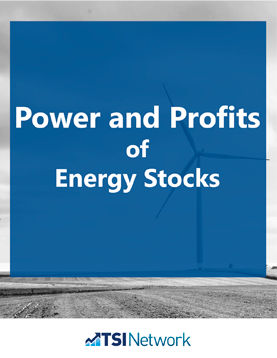Topic: Energy Stocks
35 tips for investing in TSX energy stocks successfully and making a profit
How To Pick The Right TSX Energy Stocks For Your Portfolio
The prices of many TSX energy stocks are down lately—but investing in energy shares could provide attractive long-term returns for your portfolio. As well, we recommend that most investors maintain some exposure to the Resources sector—and TSX energy stocks—as part of a well-balanced portfolio.
The direction of energy prices depends on a lot of things, particularly economic growth rates around the world, Meanwhile, though, well-established companies in the energy industry can take advantage of the setback to pick up properties and employees who might be harder to find in more prosperous times.
|
The right time for energy stocks When oil prices rise, are you positioned to profit? Pat McKeough shows you how to make the most of oil and gas stocks in this free report. Plus you get a survey of all energy stocks, including power generation, alternative and nuclear energy.
|
Most investors who are looking at investing in energy on the Toronto Stock Exchange (TSX) would likely think of oil and gas first. But energy stocks also include green energy, power from renewable resources like solar power, wind power, geothermal power, generating electricity from ocean waves, plus nuclear power.
35 Tips For Investing In TSX Energy Stocks:
- Look for oil and gas exploration companies that have cash flow from existing wells that is sufficient for, or at least contributes to, the development costs of additional wells.
- Look at the market cap of oil and gas exploration companies versus the estimated value of the reserves they have in the ground. Sometimes, a company’s marketing efforts are so successful that they drive the stock up too high in relation to the size of their findings. We like an oil and gas exploration company’s market cap to be no more than half the value of the oil and gas in the ground.
- Invest in oil and gas energy stocks that use innovative new drilling and exploration techniques. Staying ahead of the curve will keep them in business.
- Invest in oil and gas energy stocks that own diversified drilling sites in multiple geographic locations where exploration has been successful in the past.
- Junior energy stocks are risky to invest in, because it’s relatively cheap and easy to launch a penny oil or other energy stock and sell stock to the public. So the junior energy promotion business attracts more than its share of unscrupulous operators and stock promoters.
- Stay away from junior energy stocks operating in insecure and politically unstable regions like the Congo and Venezuela, or in countries with little respect for property rights and the rule of law, like Russia or Mongolia. Resource extraction is inherently a politically vulnerable business; you can’t move the oil wells to another country, and local citizens sometimes believe that a foreign resource company is robbing them of their birthright, even though they need the foreign company’s capital and expertise to get any value out of the ground.
- Invest predominently in pure-exploration junior energy shares that operate in an area with geology that is similar to that of nearby producers. Look for favourable factors, like attractive geology, not hostile environments, like the high Arctic.
- Invest in well-financed juniors with no immediate need to sell shares at low prices, since that would dilute existing investors’ interests. The best juniors have a major partner who has agreed to pay for the drilling or other exploration or development, in exchange for an interest in the property.
- Invest in juniors with strong balance sheets and low debt and positive cash flow, preferably even when commodity prices are low. Even better, we like to see junior energy stocks that have cash flow from existing wells that is sufficient for, or at least contributes to, the development costs of another prospect.
- The price of natural gas, like the price of oil, is highly volatile. It’s a bad idea to base investment decisions on predictions of future natural gas prices, because these predictions are simply not reliable.
- Weather affects prices. In the summer, natural gas prices could jump if it’s unusually hot. This leads to greater demand for natural gas-generated electricity for air conditioning, or if hurricanes were to disrupt production. Hurricane season can last until the end of November in some parts of North America.
- Natural gas prices are low. If natural gas prices continue to stay low, energy companies will have less incentive to drill for natural gas. That will lead to lower supplies and, in the long run, higher prices.
- The demand and cost of natural gas is rising. Around 60% of U.S. homes are heated with natural gas, and the clean-burning energy source is also used to generate electricity, another popular heating method. Most new electricity capacity brought on line right now is generated by natural gas, rather than oil, coal, water or nuclear. As well, when the price of crude oil increases, or remains high, some industries switch to natural gas. This leads to more demand, which could cause the price of natural gas to rise.
- Manufacturers can utilize different resources. Many manufacturers and utilities are able to switch back and forth between using natural gas, oil and electricity. If oil gets cheaper, this would lower demand, and prices, for natural gas.
- Pipelines are an important part of natural gas transmission. Natural gas is produced around the world, but the simplest way to transport gas is through a pipeline. Canada, which supplies around a sixth of U.S. consumption, is the main source of imported gas for the U.S.
- Solar energy is very reliant on government subsidies. Even though sunlight is free, solar power costs considerably more to generate than power from traditional fossil fuels. The main reason is the high cost of building solar plants. This includes the cost of solar panels, mirrors, transmission lines and generators, as well as the cost to buy or lease the land to put them on.
- Solar energy has competition from alternative power sources. Short of radical advances in solar-power technology, the long-term prospect for “grid parity”—the price at which it will be equally cheap to produce a kilowatt-hour of electricity from solar as from fossil fuels—relies in large part on the prospect of higher oil and gas prices pushing up the cost of electricity generated from those sources. When oil and natural gas prices fall, it makes investment in solar power less attractive.
- Solar energy is a rapidly changing technology. Solar power has attracted a lot of investment in recent years. That has quickly moved the technology forward. For example, advances in manufacturing techniques continue to steadily push down the prices of solar cells and solar panels. At the same time, alternatives to costly silicon, which is currently used in most solar cells, are emerging. These include copper-indium-gallium-selenium solar cells. Technology advances add considerably to the risk of solar-power companies that are focused on developing or making a single technology. That’s because they constantly risk being overtaken by competitors with a superior product.
- While wind power stocks have appeal for a lot of investors on an emotional and conceptual level, many offer only limited investment potential. That’s because most need heavy government subsidies to be profitable—and an economic crisis could prompt governments to cut promised, or even agreed upon, subsidies.
- Wind power has been used for centuries. It’s been used around the world through the use of windmills for pumping water and milling grain. Historically, windmills are most associated with Holland, where they have been used extensively for centuries. Today, wind power plants use large blades to catch the wind, turning rotors in turbines that produce electricity.
- Wind power has one key problem—it generates fluctuating power output, due to the variability of wind speed. These variations can be as short in duration as gusts. But wind speed also changes from day to night, and there are seasonal and even annual changes in wind strength. This variability means that utilities must maintain backup power capacity or costly storage, equal to their reliance on wind power. This complicates the stability of a power grid; it creates difficulties in power scheduling and technical problems related to voltage control. All these factors can cut the price that utilities are willing to pay for wind power.
- Wind power can become less attractive after comparing the cost of building wind plants in relation to the potential return from the sale of power. This includes the price of the turbines and the cost to buy or lease the land to put them on. The cost of installation can be excessive, depending on the terrain and the distance from the power grid. Risking a large amount of capital for a technology that still is considered new and unproven makes it necessary in most cases to rely on government subsidies to attract investors.
- Wind power stocks also face high construction costs. These include the cost of the turbines themselves, plus buying or leasing the necessary land. Installation can also be expensive, depending on the terrain and distance from the power grid. Not surprisingly, many of these companies are heavily reliant on uncertain government subsidies and political support.
- Uranium stocks pose a unique challenge for investors who are a looking to diversify their natural resource holdings. Uranium’s radioactive properties and use in nuclear weapons and reactors make it a controversial energy source.
- There is a long lead time from exploration and discovery to production. That’s especially so with uranium, which needs extra regulatory approval because of its radioactivity. When we’re researching a uranium mining stock, we look for ones that operate in an area with geology that is similar to that of nearby producing mines. Exploration of new areas where uranium hasn’t historically been present is a gamble at best and should be avoided.
- We recommend looking into uranium stocks that operate in the United States, Brazil and South Africa. Several countries have significant uranium resources, like Niger, Namibia, Ukraine, Uzbekistan, Mongolia, and Jordan. However, we generally stay away from mining companies that operate in insecure and politically unstable regions like these.
- When looking at uranium stocks, we also avoid those in countries with little respect for property rights and the rule of law, such as Russia or Mongolia. Mining is particularly vulnerable to political instability. You can’t move the mine to another country, and local citizens may sometimes get the impression that a foreign mining company is robbing them of their birthright, even though the foreign company’s capital and expertise would appear to be the best way to get any value out of the ground.
- Uranium by its very nature is radioactive. This increases the environmental constraints that will come into play when mining for this mineral. Uranium stocks will need to have strong balance sheets and environmentally sound mining practices. Regulation and containment of uranium ore is very costly.
- When recommending uranium energy stocks, we look for low debt, because debt can be a problem for any mining company. When we recommend uranium mining stocks, we want to see positive cash flow, preferably even when uranium prices are low. Even better, we like to see mining companies that have cash flow from an existing mine that is sufficient for, or at least contributes to, the cost of developing a second mine.
- We look for uranium stocks that have an experienced management team. We like to see teams that have a history of mine development and have financed similar projects in the past.
- Many workers are killed in coal-mining accidents every year (particularly in China). And unlike nuclear power, burning coal and oil to produce electricity results in the emission of harmful pollutants.
- Nuclear power continues to have many environmental advantages over power generated using coal and other fossil fuels, even after the March 2011 earthquake and tsunami that led to a release of radiation at the nuclear plant in Fukushima, Japan.
- Canadian Pacific Railway (Toronto symbol CP) is one of most promising coal energy stocks because it has an exclusive contract to ship coal from five of Teck Resources’ southeastern B.C. mines to the Port of Vancouver. Coal shipments from Teck and other miners account for around 10% of the railroad’s revenue.
- Recent years have seen many companies selling their coal interests. In 2014, Sherritt International, which produces nickel from operations in Cuba, Canada and Madagascar, and has oil and gas operations in Cuba, Spain and Pakistan—sold its coal assets to pay down debt.
- Back in 2010, the federal government announced plans to phase out older coal-fired power plants by around 2025. Utilities would have to close coal-fired plants when they reach 45 years of age or when their power-purchase contracts with provincial electricity regulators expire, whichever is later. The new rules would prevent utilities from extending the lives of these plants unless they can lower their carbon emissions to the same level as natural-gas-fired plants. This has caused some plants to convert to gas-powered facilities.
What To Know About Investing In TSX Energy Stocks Through Juniors:
What To Know About Investing In TSX Energy Stocks Through Natural Gas Companies:
What to Know About Investing in TSX Energy Stocks Through Solar Power Companies:
What To Know About Investing In TSX Energy Stocks Through Wind Power:
What To Know About Investing In TSX Energy Stocks Through Uranium
What To Know About Investing In TSX Energy Stocks Through Coal Companies
TSX energy stocks, and energy stocks in general have generally been below-average performers lately, and many investors are tempted to get out of the industry altogether. However, the energy segment can play a crucial role in your portfolio as a hedge against inflation. The low inflation rates of the past couple of decades deserve much of the blame for the poor performance of the sector. When they rebound, energy stocks could grow significantly for years to come.
You can profit over the long term by investing in well-established and well-managed energy companies on the TSX that are active in businesses that involve highly volatile commodities like oil and gas. You profit all the more if you buy these companies when they are cheap in relation to earnings and assets.
We recommend that uranium and coal stocks make up only a limited portion of your portfolio’s resource segment. The demand for uranium and coal may increase but it will take a keen investment eye to find the most profitable uranium stocks to invest in.
Do the hidden assets of renewable energy companies make it worth the risk to invest in them? Or do you prefer to stick with traditional TSX energy stocks?
Which energy stocks do you invest in based on favourable results over a sustained period? How did you find these investments originally?
This article was originally published in 2016 and has been updated.




